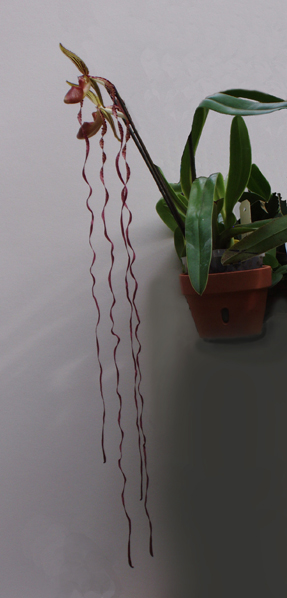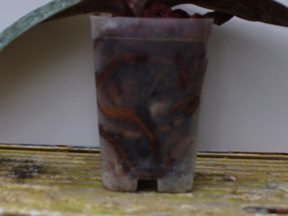


Winter is the time when spikes from the multiflora Paphs in my
collection suddenly appear. Paphs are not a group of orchids that
I used to have in my collection, but gifts over the years brought the
occasional Paph that would flourish for awhile and then suddenly decline
because I did not repot them frequently enough. After reading an
article on Paphs in their natural habitat, I realized that they
typically grow in limestone outcrops so high acidity in decaying media
seemed like a logical explanation for the decline in growth as the
medium degraded.
A visit from Paul Phillips confirmed what I suspected; dolomite
limestone aided Paph growth and was discovered long ago by English Paph
growers. For many years, I added pelletized lime to my Paphs every
month or so. If I forgot, I would notice a change in leaf color on
a few Paphs that would prompt me to add lime. Within a week, I
could see the color change in my Paph leaves reverted to its normal
light green color. With this regimen, I could go a year without
repotting, but still the medium degraded too quickly for my taste.
Perhaps Paph lovers enjoy repotting, but those of us that grow cattleyas
find repotting a chore; hence, my search for another medium. The
use of lava rock as a medium for Paphs was almost accidental. A
large plant of Paph Lady Isabel fell off the bench and a growth broke
off leaving its roots behind. I threw the growth into a clear
plastic pot, which immediately fell over from the weight of the plant.
I was experimenting with lava rock for my cattleyas at the time, so I
threw a handful of lava rock into the pot to keep it from tipping over
and set it among the other Paphs with the intention of repotting as soon
as I got some Paph mix. Needless to say, I forgot about the plant
until I saw a large spike emerging on the Paph bench. When I
lifted the plant the root system had almost filled the bottom of the pot
and there were two new growths.

Rock does not seem like a medium that Paphs would like because Paphs
like constant moisture in their medium. They have fine roots,
which dry out quickly. How could they survive in rock? As I
experimented with lava rock as a medium it became clear that lava rock
had an ability to absorb a large quantity of water once it had
weathered. Initially, I used pea sized lava rock right out of the
bag, but would find a layer of fine, red sand at the bottom of the pot
after a few months. Paphs in this mix often had dead roots similar
to situations where the medium had degraded.
After several iterations it became clear that the lava rock had to be
weathered by soaking in water for a few weeks or left outside to loosen
the fine grains of sand from the porous surface. This is not
necessary with most rock materials. Also, it was clear that larger
size lava rock was necessary to allow enough air movement around the
roots. Half inch diameter worked best, although in larger pots one
inch diameter or larger is placed in the bottom to increase drainage.
Dolomite lime, preferably the pelletized form, is still added to the
surface because it lasts longer, but the powdered form will work just as
well. When I used rainwater, which was acidic, lime was added
monthly, especially in summer when orchids were watered two or three
times per week. The combination of lava rock and lime led to Paph
roots that would fill the plastic pot and occasionally deform it from
their expansion. Often the pot would need to be cut to remove the
Paph, but only after several years’ growth. At last, no repotting.
The only modification in this protocol occurred after my move to